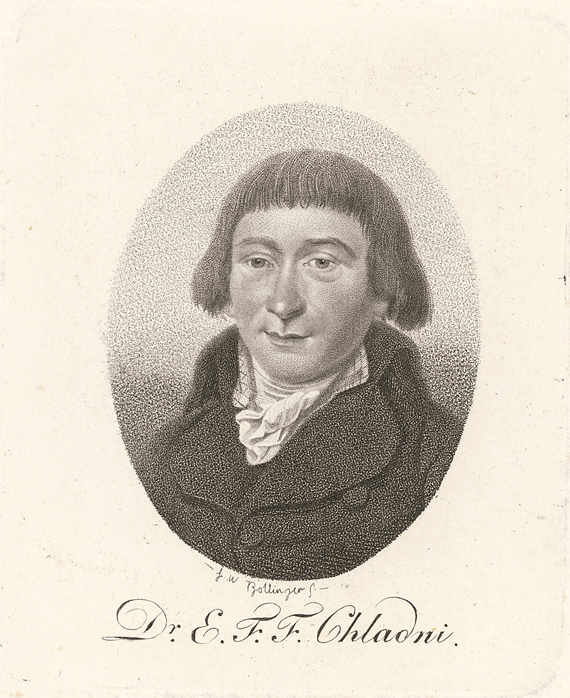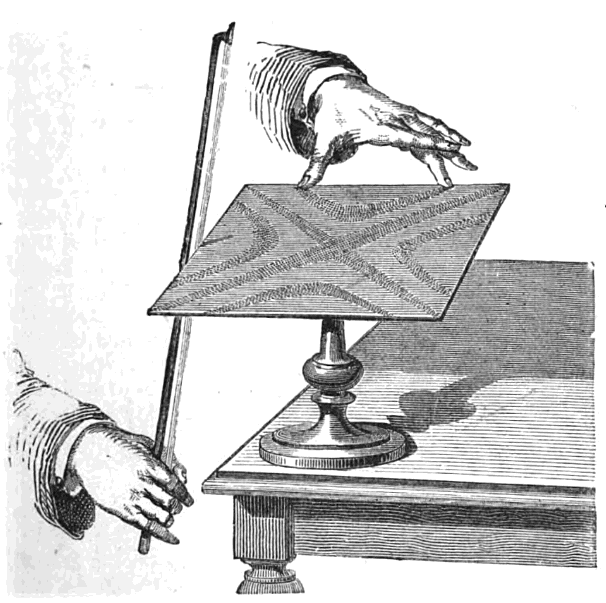
Ernst Chladni (1776-1827)
On November 30, 1756, German physicist and musician Ernst Florens Friedrich Chladni was born. His most important work, for which he is sometimes labeled the father of acoustics, included research on vibrating plates and the calculation of the speed of sound for different gases. He also undertook pioneering work in the study of meteorites and so is also regarded by some as the father of meteoritics.
Ernst Chladni – Early Years
Although Ernst Chladni was born in Wittenberg in Saxony, his family originated from Kremnica, then part of the Kingdom of Hungary, today Slovakia. Hence Chladni has been identified as German, Hungarian as well as Slovak. Chladni came from an educated family of academics and learned men. Chladni’s grandfather, Martin Chladni (1669–1725), a Lutheran theologian, became professor of theology at the University of Wittenberg and was dean of the theology faculty in 1720–1721 and later became the university’s rector. Chaldni’s uncle, Justus Georg Chladni (1701–1765), was a law professor at the university. Chladni’s father, Ernst Martin Chladni (1715–1782), was a law professor and rector of the University of Wittenberg. As a consequence of the Reformation in the 16th century, Wittenberg had become the cultural centre of Europe due to the work of Martin Luther and Philipp Melanchthon, and the University Leucorea of Wittenberg was considered the most important north of the Alps. In the 18th century, however, Wittenberg had meanwhile degraded to the status of a provincial town in Saxony, and the university as well had lost its great renown. [2] Chladni received home education; his father had very strict, even despotic way of upbringing. Ernst Friedrich could only leave his study room after his permission; couldn’t go even to their garden other than accompanied by his mother; and was not allowed to have any friends. [2]
An Interest in Acoustics
Unfortunately, Ernst Chladni’s father disapproved of his son’s interest in science. Despite he wished to study medicine, Chladni’s father insisted that Ernst must study law. Thus, Chladni studied law and philosophy in Wittenberg and Leipzig, obtaining a law degree from the University of Leipzig in 1782. That same year, his father died and he turned to physics. He moved to acoustics as a relatively underexplored scientific field at the time.[2] One of Chladni’s best-known achievements was inventing a technique to show the various modes of vibration of a rigid surface. When resonating, a plate or membrane is divided into regions that vibrate in opposite directions, bounded by lines where no vibration occurs (nodal lines). Chladni repeated the pioneering experiments of Robert Hooke who, on July 8, 1680, had observed the nodal patterns associated with the vibrations of glass plates. Hooke ran a violin bow along the edge of a plate covered with flour and saw the nodal patterns emerge [4].
Discoveries in the Theory of Sound
Chladni’s technique, first published in 1787 in his book Entdeckungen über die Theorie des Klanges (“Discoveries in the Theory of Sound“), consisted of drawing a bow over a piece of metal whose surface was lightly covered with sand. The plate was bowed until it reached resonance, when the vibration causes the sand to move and concentrate along the nodal lines where the surface is still, outlining the nodal lines. The patterns formed by these lines are what are now called Chladni figures. Similar nodal patterns can also be found by assembling microscale materials on Faraday waves. At the end of this book Chladni reminded of the unsolved problem of the mathematical treatment of flexural vibrations of plates.[2]

Chladni’s method of creating Chladni figures
Euphon and Clavicylinder
Variations of this technique are still commonly used in the design and construction of acoustic instruments such as violins, guitars, and cellos. Since the 20th century, it has become more common to place a loudspeaker driven by an electronic signal generator over or under the plate to achieve a more accurate adjustable frequency. In 1791, Chladni invented the musical instrument called the euphon (not to be confused with the brass instrument euphonium), consisting of glass rods of different pitches. Chladni’s euphon is the direct ancestor of the modern day musical instrument known as the Cristal Baschet. Chladni also improved on Hooke’s “musical cylinder” to produce another instrument, the clavicylinder, in 1799. Caladni quickly came to be known as a “traveling scientist”, and used the visits of various cities to acquire new contacts among scientists but also to study various materials on acoustics in its libraries and archives.
The Extraterrestric Origin of Meteors
In 1792, Chladni visited Göttingen, where he met and befriended Georg Christoph Lichtenberg, which was the beginning of Chladni’s interest in meteors and later his theory of their extraterrestric origin.[5] This was a controversial statement at the time, since meteorites were thought to be of volcanic origin. His 1794 published book on that subject Über den Ursprung der von Pallas gefundenen und anderer ihr ähnlicher Eisenmassen und über einige damit in Verbindung stehende Naturerscheinungen (“On the Origin of the Iron Masses Found by Pallas and Others Similar to it, and on Some Associated Natural Phenomena“) made Chladni one of the founders of modern meteorite research. Chladni was initially ridiculed for his claims, but his writings sparked a curiosity that eventually led more researchers supporting his theory.
Raising the Interest of Goethe and Schiller
In 1803 Chladni met Johann Wolfgang von Goethe [6] to whom he gave a copy of his newly published book “Acoustics” (1802). About their first encounter, Goethe wrote the following in a letter to Friedrich Schiller: “Doctor Chladni has arrived and has brought his complete Acoustics in a quarto volume. I have already read half of it and shall give you a somewhat agreeable oral report on its content, substance, method, and form. He belongs to [..] those blissful persons who have not the faintest idea that there is something as Naturphilosophy and who are only attentively trying to observe phenomena which they will then classify and make use of them as well as their natural talent is capable in the matter and is trained for the matter.“[7]
Honors and Death
In 1793 he was elected corresponding member of the Göttingen Academy of Sciences. Since 1794 he was corresponding member of the Russian Academy of Sciences in Saint Petersburg. In 1804 he was admitted as corresponding member of the Bavarian Academy of Sciences and in December 1815 of the Prussian Academy of Sciences. Chladni lived and worked until 1813 in his native town of Wittenberg, from 1813 in neighbouring Kemberg. Chladni died during a lecture tour in 1827 in Breslau, Lower Silesia, then part of the Kingdom of Prussia and today the city of Wrocław in southwestern Poland, where he was buried in the Great Cemetery.
Charles Taylor, Demonstrating Resonance with Chladni Figures – Christmas Lectures with Charles Taylor [11]
References and Further Reading:
- [1] Sophie Germain and the Chladni Experiment, yovisto blog, June 27, 2014.
- [2] Ernst Chladni, at monoskop.org
- [3] “Chladni, Ernst Florenz Friedrich.” Complete Dictionary of Scientific Biography. 2008. Encyclopedia.com.
- [4] Robert Hooke and his Micrographia, SciHi blog, July 18, 2013.
- [5] Georg Christoph Lichtenberg – Master of Aphorism, SciHi Blog
- [6] The Life and Works of Johann Wolfgang von Goethe, SciHi Blog
- [7] ‘Art is the Daughter of Freedom’ – Friedrich Schiller, SciHi Blog
- [8] Works by or about Ernst Chladni, via Wikisource
- [9] Die Akustik, 1802 by Ernst Chladni at Universities of Strasbourg
- [10] Ernst Chladni at Wikidata
- [11] Charles Taylor, Demonstrating Resonance with Chladni Figures – Christmas Lectures with Charles Taylor, The Royal Institution @ youtube
- [12] Marvin, Ursula B. (1996). “Ernst florens Friedrich Chladni (1756–1827) and the origins of modern meteorite research”. Meteoritics. 31 (5): 545–588.
- [13] Rossing T. D. (1982) Chladni’s Law for Vibrating Plates, American Journal of Physics 50, 271–274
- [14] Timeline of German physicists, via DBpedia and Wikidata






Pingback: Whewell’s Gazette: Year 2, Vol. #21 | Whewell's Ghost
Pingback: Whewell’s Gazette: Year 3, Vol. #16 | Whewell's Ghost